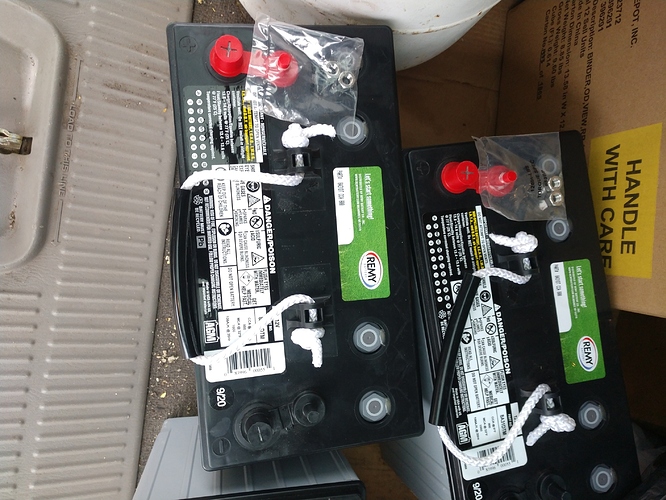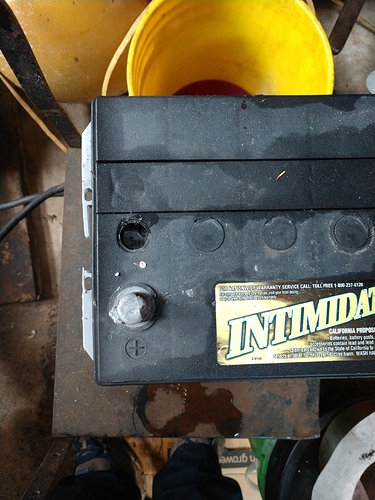thanks Bill, try now.
So this only allows for AC battery charging? I don’t see any DC inputs.
48v input, ac charger when batteries drop to set point. I don’t know if I’ll use this function, my charge controllers have an auto generator start when batteries drop.
Just a thought…
What if you use your gasifier to run a generator to charge a DIY lithium battery pack and use the energy whenever you like…?Is this feasible?
Any comments?
That is what i do Andreas , i use the gasifier to to top up or fully charge my batteries on cloudy or over cast days , as long as your generator is running you can just plug your charger into it and away you go , just make sure your generator is rated just over double the kw you would normally need for charging your battery bank due to power loss running on wood gas .
Dave
Thank you for your reply.What kind off batteries do you use?I m thinking to build a DIY lithium battery pack or buy a Tesla power wall (actually a Chinese one from Alibaba)
Thats exactly how you should be using this technology. Only use a gasifier for direct power for heavy loads. Other than that use it to top off a battery bank system. This is how you store the gas, you convert it to DC and store it. Use solar to make it less demanding on you.
For applications where you think you need to store gas to run those applications? You are simply doing it wrong, get rid of those systems and replace them, with more practical solutions. Wood fired hot water heater for instance or combine that into your daily running as you charge your bank. For cooking, make charcoal, use electric; you can not use this gas for that anyways if using for an indoor NG / LPG stove. There is no reason you should need to store this gas, there are better and other alternatives.
You will never sustain a full time gasifier, or at least you wont want too after the magic wears off. lol
Hi Andreas , i am using a mixture of both lead acid very heavy forklift batteries and a newer lifepo4 batteries , but for your case being up high i would just stick with the lifepo4 as they are so light compared to lead acid and also much much safer on a confined area like your balcony , before you go shopping on Alibaba make sure you speak to as many people as you can as there are a lot of these cells around that are not what they say they are in way of capacity i have heard of some sellers selling passing off B grade batterys as A grade , take a look at this company they sometimes have some very good bargains and even with the cost of shipping they can still work out much better than new ones .
Sign up to there news letter and get there latest offerings, if you see something you like fill in your address details country ect ect till you get to the shipping page to get a cost of the item delivered to your door .
Dave
‘‘i am using a mixture of both lead acid very heavy forklift batteries and a newer lifepo4 batteries’’ , How are you hooking up the different batteries, this is what I want to do. Are you using them on the same system? How long have you been using the forklift battery?
Hi Al , sorry i did think as typing ,i must remember to say that i have 12 , 24 and a 48 volt banks of course non are linked together i just move the lead acid cells to another bank as they wear out , the lifepo4 is all alone as a 12 volt bank
Dave
So after whining about battery prices, the usual fall battery shuffle, and finally the “click, click, click” of the starter solenoid, telling me that the van battery had had it, I did what all mainstream grid connected sheeple do…I went to Remy and bought batteries.  I feel like I have punked out, betrayed the movement, or rolled over for the Man. There is a lot of shame there. Still, a new hot battery, four new winterforce tires, and a heater stuck on high defrost, makes me very optimistic about the coming winter.
I feel like I have punked out, betrayed the movement, or rolled over for the Man. There is a lot of shame there. Still, a new hot battery, four new winterforce tires, and a heater stuck on high defrost, makes me very optimistic about the coming winter.
Soooo, while I was at Remy, I saw they had these 8A31DTs. They really seem to be sealed AGM batteries…I bought enough of them to get the price down to $252 per. Has anyone ever tried this brand…Penn?
I bought the intimidater AGM Batts 4 years ago and they claim to be sealed, but they boiled off their electrolyte. My guy at Remy wants them back because they never heard of them leaking gas, or liquid. These were Penn batteries too.
These new ones seem to be comparable to my Trojan 12v gel cells, but they claim to be AGM sealed.
What were you using to charge them? I have not used AGM batteries much myself, but I read that they do not like being overcharged (I.E. using an alternator or a charger with a charge profile for flooded batteries) I forget what the voltage threshold is where a lead acid will start to gas, but I want to say its around 2.4v/cell.
I couldnt find specs for that Remy battery, but trojan is good about providing documentation. Here is a 12v agm they make, and it suggests 2.4v as the absorbtion voltage and then dropping down to 2.25/cell during float.
Also, it says not to exceed 20% of the c20 rate when charging, so not more than about 21amps per battery in your bank (of 8A31DTs) is probably a good rule of thumb.
Thanks carl. My point about the intimidator batteries was that they really were flooded as the picture shows. So an AGM profile wouldn’t have done them any good at all.
Making wood into a usable fuel I have a good wood chipper , but it produced more waste then usable quarter sized chips so I abandoned the 50 thousand dollar investment . AND built something out junk I had on hand . There is great resistance to my continued spending for no return . AND the thing I built out of junk worked as well as the thing I spent 50 thousand dollars on . I did not put any power to the grid . I did not damage my hearing .
What has been shown is you can power an engine for a set period of time with a set amount of fuel .
I was sending power back to grid and I spent 50 thousand dollars to do that . If I had the intention and had spent another thousand dollars I could use some of this power myself .
Topic was storing power that you made and I said all this to suggest something few of you could use pumped hydro storage , Water wheel DC generator . I could do this . When the water turns to ice it will not work well . Have water over wheel fall below wheel then pump it above wheel again .
I did this too. I built a system with 5 stages of redundancy, with enough power to run a heat pump and an electric kitchen. $20k in batteries, 40k in solar components, and the tiltable mount, oh God the mount. It took one entire summer and 100lbs of welding rod to make that mount. 35ft 4x4 steel trusses. Most of the weight is buried in the concrete base. I really doubt it was built for less then 70k. It tilts to 100 degrees. We tip it up at the equinox with a 644 JD loader. At it’s over vertical stage it sheds the snow and still brings in a kilowatt from the Albedo off the snow. In June it’s an 8 kilowatt set up but doesn’t track the sun, so it loses the dawn and sunsets.
The guy I built it for believes in the Revelation.
For an extra hundred bucks he got a permit and a smart meter and sells power back wholesale…I think it’s 3cents a kilowatt-hour. He gets a credit. I was disgusted. He didn’t really care.
I have not done the math for pumpable storage. We could do it here. I have nearly every thing we would need. I don’t have any pond liner tho. I would have to go visit some of my Halliburton friends. My suspicion is that given I only have 60ft of head, it would have to be a pretty big pond. My soil is sandy cobble and doesn’t hold water at all. There is no clay here. Trimountain Cobble. I would have to do the math. It’s a fun calculation.
I do think pumpable storage would be a practical solution. For winter, I would bury the turbine under 5 feet of working chips or green hay. I will have to ponder this.
Running a quick calculation, it looks like I would get a theoretical max of 20watts per liter per second with a linear relationship.
To the many new-to-this, one of you needs to explain “C” factor as related to storage batteries charging.
“No. No. Not Me” said Richard Greer in Pretty Woman. “xxxx Her xxx”
S.U.
Maybe a more apt name would be Imitator batteries? Those seems sort of sketchy.
The math does not pencil out on a small scale. I was interested in gravity storage for a while, but the energy density is abysmal. I had thought about some sort of cart that could be winched up a hill, but to get any sort of meaningful storage would require way too much infrastructure. Water is a bit easier to deal with, but it would still require too much overhead to ever make sense, I think. Its a cool concept though, and theoretically would not be difficult to do on a small scale.
The c-rate percentage I was referring to was from that PDF I linked to for the trojan batteries. It states that the maximum charging amps should not exceed 20% of the c-20 rate for that battery. The c-20 rate is the standard that is used to label the amp-hour capacity of lead acids. It refers to a discharge rate that will empty the battery in 20 hours. If you discharge at a higher rate, say 5 hours (you guessed it, the c-5 rate) you will not get as much energy out because lead acid batteries are ancient, and they waste a lot of energy as heat at higher loads. Long story short, those Trojan AGM batteries with a c-20 rating of 140Ah should not be charged at more than 28A.
I love stuff like this. I always wanted to build a giant wind up system like this to run an AC output generator. You could very easily control its rpm. This like a wind up toy or watch. Another method would a linear spring or closed loop compressed gas cylinder type system. It then drive a linear ball screw to convert to rotating power. With compressed gas you can control with valve metering to boost or lower output to meet the load. Compression you get back what you put in, however you would have mechanical losses.
That is one cool fan ! when you gonna start building them Matt ? lol 




